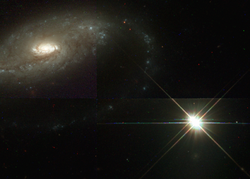Astronomy:NGC 4500
From HandWiki
Short description: Galaxy in the constellation Ursa Major
| NGC 4500 | |
|---|---|
 HST image of NGC 4500 | |
| Observation data (J2000 epoch) | |
| Constellation | Ursa Major |
| Right ascension | 12h 31m 22.15431s[1] |
| Declination | +57° 57′ 52.6226″[1] |
| Redshift | 0.0110[2] |
| Helio radial velocity | 3280 km/s[2] |
| Distance | 157.5 Mly (48.30 Mpc)[3] |
| Apparent magnitude (V) | 12.52[4] |
| Apparent magnitude (B) | 13.12[4] |
| Characteristics | |
| Type | SB(s)a[5] |
| Other designations | |
| UGC 7667, MCG+10-18-062, PGC 41436[2] | |
NGC 4500 is a barred spiral galaxy in the constellation Ursa Major. The galaxy was discovered on April 17, 1789 by William Herschel.[6] It is a blue compact galaxy.[2]
Its distance from Earth is approximately 50 million parsecs.[3]
See also
References
- ↑ 1.0 1.1 Brown, A. G. A. (August 2018). "Gaia Data Release 2: Summary of the contents and survey properties". Astronomy & Astrophysics 616: A1. doi:10.1051/0004-6361/201833051. Bibcode: 2018A&A...616A...1G.
- ↑ 2.0 2.1 2.2 2.3 "NGC 4500". SIMBAD. Centre de données astronomiques de Strasbourg. http://simbad.u-strasbg.fr/simbad/sim-basic?Ident=NGC+4500.
- ↑ 3.0 3.1 Crook, Aidan C.; Huchra, John P.; Martimbeau, Nathalie; Masters, Karen L.; Jarrett, Tom; Macri, Lucas M. (2007). "Groups of Galaxies in the Two Micron All Sky Redshift Survey". The Astrophysical Journal 655 (2): 790–813. doi:10.1086/510201. Bibcode: 2007ApJ...655..790C.
- ↑ 4.0 4.1 "Search specification: NGC 4500". HyperLeda. Université Claude Bernard Lyon 1. http://leda.univ-lyon1.fr/ledacat.cgi?o=NGC%204500. Retrieved 2021-02-04.
- ↑ "Results for object NGC 4500 (NGC 4500)". NASA/IPAC Extragalactic Database. California Institute of Technology. https://ned.ipac.caltech.edu/byname?objname=NGC%204500&hconst=67.8&omegam=0.308&omegav=0.692&wmap=4&corr_z=1. Retrieved 2021-02-04.
- ↑ "New General Catalog Objects: NGC 4500 - 4549". http://cseligman.com/text/atlas/ngc45.htm.
External links
 |

